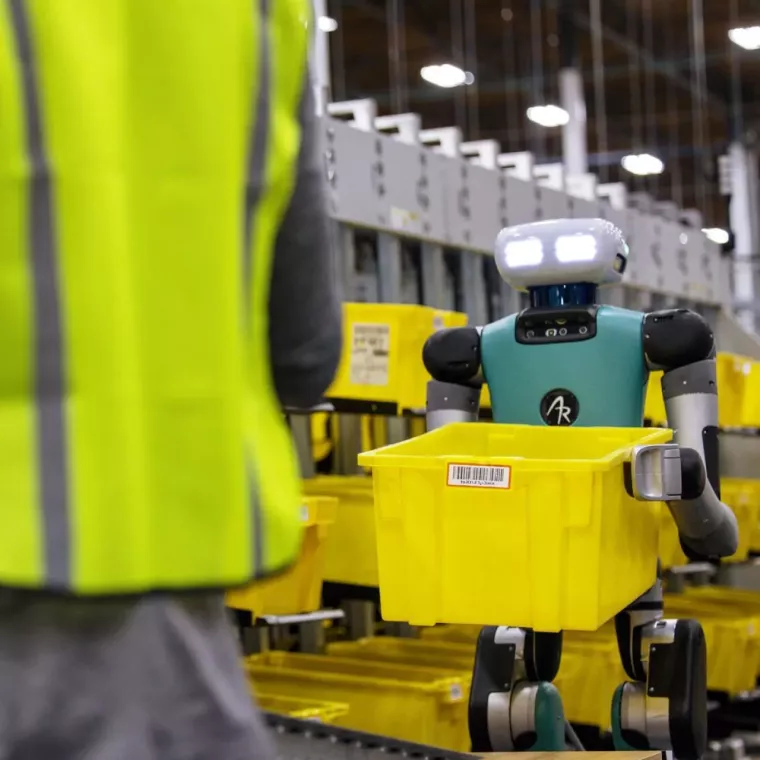
The Amazon Industrial Innovation Fund is a $1 billion venture investment program that supports emerging technology companies with direct investments. The Fund aims to help spur and support warehouse automation and supply chain innovation and, since launching in 2022, has made close to a dozen investments in promising technologies.
Most recently, investments have been made in Rightbot, which is developing a system to automate the unloading of containers, and Instock, which has designed a robotic storage and retrieval system that offers efficient inventory management.
Franziska Bossart recently joined Amazon to lead the Industrial Innovation Fund and has over 20 years of experience working in corporate venture capital and digital transformation. Her past investments have focused on industrial automation, robotics, and climate tech for companies based in North America, Europe, and Asia.
Amazon asked Bossart about the latest trends in supply chain technology and where she sees future investments with the Amazon Industrial Innovation Fund.
Q: What are your goals for the Amazon Industrial Innovation Fund in 2024, and how is it evolving?
A: Our vision to help accelerate automation and supply chain innovation continues to be a key priority and unlock how we can better deliver for customers and improve our workplace for employees. This year, we want to further establish the Fund as a venture investor of choice for innovative startups of all sizes within the robotics, fulfillment, and logistics space.
I got a rare peek inside an Amazon robotics facility and saw how fulfillment center robots are made and tested It’s not every day you see one of humankind’s coolest creations come straight off the conveyor belt. Get a sneak peek at the process of building a ‘Hercules’ robot at the Amazon Global Robotics facility in Westborough, Massachusetts.
In 2024, the Fund will expand to also invest in transportation, including autonomous vehicles and last-mile technologies. We have gained a lot of momentum going into this year, and we are eager to support more promising startups as they scale to solve the most relevant industrial problems for Amazon and beyond.
Q: What are some trends you expect to see across industrial technology investments this year?
A: With the help of artificial intelligence (AI) and machine learning, algorithms have enabled us to develop technologies that can process large amounts of data, make decisions, and learn from experience. I believe in 2024, we’ll see more widespread use of these intelligent systems. The groundwork for this technology has been in development for decades, but now we’re seeing many pieces coming together to further drive innovation. Advances in perception, AI, manipulation, and control are helping us automate a broader range of tasks.
Progress in computer vision systems has also been remarkable. Take for instance the headway being made by one of our Fund portfolio companies, Vimaan, which has developed AI solutions to accurately view warehouse inventory. Their technology can help capture the dimensions and weight of freight within seconds, reducing operating costs and speeding up how quickly we can deliver goods.
New approaches with hardware hold a great deal of promise as well. I believe there will be meaningful progress with bi-pedal robots in 2024, and we’re interested in further exploring this space. Last October, we announced with Agility Robotics a new pilot to test their Digit robot in our operations, and we’re looking forward to learn more about how we can use a mobile manipulation system within our operations.
Q: What technologies do you think have the most potential for industrial application?
A: Collaborative technology, where people can work alongside the system, has great potential for industrial application as it can improve and streamline operations and processes while improving safety. The fulfillment technologies we have developed within Amazon have created a safer workplace that reduces repetitive motions and the need to walk long distances or move heavy objects. It also allows our employees to focus on new tasks where they can deliver more value for our customers.
How Amazon deploys collaborative robots in its operations to benefit employees and customers
750,000 Amazon robots are doing the heavy lifting for our employees so they can deliver for customers. With the latest in AI, our technology makes our sites safer and enables employee upskilling.
Company data shows that recordable incident rates and lost-time incident rates were 15% and 18% lower, respectively, at Amazon Robotics sites than they were at its non-robotics sites in 2022. We are always looking for ways to further advance our safety objectives and are keen to find other likeminded companies working in this space. Modjoul, which was one of our first investments, has created an entire suite of technology that supports workplace safety and risk reduction powered by data analysis.
Q: What role do you think technology will play in Amazon operations in the years to come?
A: Technology will keep playing a significant and ever-increasing role in fulfillment centers, and we will see more and more technology adoption throughout our network, including in middle and last mile delivery, which will help us get orders to customers even faster. Take Amazon’s Sequoia system as an example. By integrating multiple robot systems to containerize our inventory, Sequoia will allow us to identify and store inventory we receive at our fulfillment centers up to 75% faster than we can today.
Automation technologies are great at taking on repetitive and predictable tasks; by doing so, they can free up employees to take on new responsibilities. We see this path continuing, allowing us to offer training to our employees in new career paths that will enable them to work with more cutting-edge technologies. Since Amazon introduced robots into its operations, we’ve created hundreds of thousands of new jobs and over 700 categories of new skilled roles within Amazon that didn’t exist within the company beforehand.

There are no comments
Please login to post comments